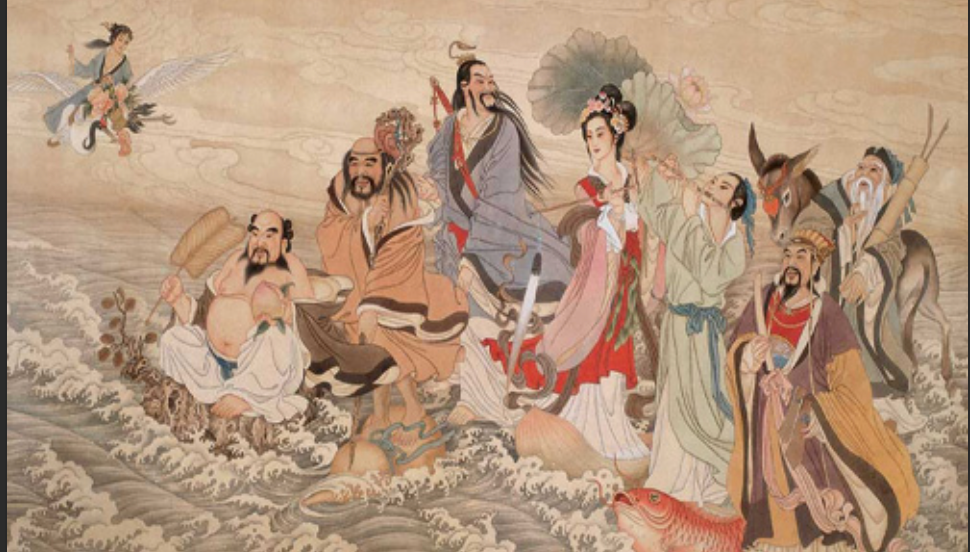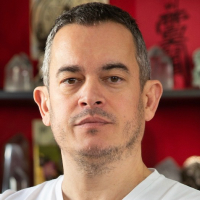Histoire et Qi Gong des 8 Immortels
-

Entreprendre une exploration approfondie des huit Immortels taoïstes, en exposant leur histoire respective et en associant à chacun d’eux une pratique de Qi Gong spécifique inspirée de leur symbolisme, est une approche à la fois spirituellement féconde et pédagogiquement puissante.
Elle permet non seulement de comprendre les archétypes taoïstes en action, mais aussi d’incarner leurs qualités à travers le mouvement, la respiration et l’intention.
Je vais donc vous proposer, pour chacun des Huit Immortels :
• Une présentation narrative, synthétisant sa légende et son rôle symbolique dans le corpus taoïste.• Une pratique de Qi Gong adaptée, inspirée de son énergie, de son objet magique, de son élément cosmique et de ses vertus spirituelles.
Ces exercices sont conçus comme des pratiques énergétiques, méditatives et symboliques, permettant de canaliser la qualité propre à chaque immortel dans une démarche d’alignement intérieur avec le Tao.
L’importance des Huit Immortels (Ba Xian) dans la tradition taoïste, tant sur le plan théorique que pratique, est profonde, plurielle et symboliquement très riche. Ces figures semi-légendaires, populaires dans l’imaginaire chinois depuis la dynastie Tang et surtout la dynastie Song, incarnent une synthèse remarquable entre cosmologie, spiritualité, moralité, et accessibilité du Tao. Ils occupent une place unique dans le panthéon taoïste, à la fois en tant que modèles d’accomplissement spirituel, vecteurs d’enseignement ésotérique, symboles de transformation alchimique, et intercesseurs dans la piété populaire.
Pour bien comprendre leur rôle, il convient de les analyser selon deux grandes dimensions : leur valeur doctrinale et symbolique dans la théorie taoïste, puis leur place dans la pratique religieuse, rituelle, dévotionnelle et méditative.
Les Huit Immortels ne sont pas des divinités lointaines et inaccessibles, mais des êtres humains ayant atteint l’Immortalité (xian, 仙) par la pratique du Tao, grâce à diverses méthodes spirituelles telles que l’alchimie interne, la méditation, le contrôle du souffle, ou encore la pratique vertueuse et l’ascèse morale.
En ce sens, ils incarnent l’idéal de transformation spirituelle cher au taoïsme : le passage de l’homme ordinaire à l’homme éveillé, unifié au cosmos, affranchi des lois de la matière et du temps.
Le fait que ces huit personnages soient très différents dans leur origine sociale et leur caractère n’est pas anodin : on y trouve un vieillard (Zhang Guo Lao), un jeune garçon (Lan Caihe), une femme (He Xiangu), un mendiant (Li Tieguai), un érudit (Lu Dongbin), un général (Zhongli Quan), un noble (Han Xiangzi), et un artisan ou joueur de flûte (Cao Guojiu). Cette diversité souligne un principe fondamental du taoïsme : l’accès au Tao est universel, il transcende les statuts sociaux, le sexe, l’âge, la richesse ou la pauvreté. Chacun peut, par sa voie propre, atteindre la transformation spirituelle.Sur un plan symbolique, les Huit Immortels incarnent également les forces fondamentales de l’univers :
• Ils sont associés aux huit trigrammes du Bagua, fondements cosmologiques du changement universel selon le Yi Jing.
• Chacun possède un objet magique, emblème de sa puissance spirituelle et outil d’intervention dans le monde, reflétant des qualités énergétiques spécifiques.
• Leur nombre, huit, n’est pas arbitraire : il évoque les quatre directions cardinales et leurs intercardinaux, marquant leur maîtrise totale de l’espace cosmique.et ils ont aussi un conte initiatique tres important.
Par leur immortalité, ils démontrent la réversibilité de la condition humaine : là où la vie semble s’achever dans la mort, le Tao ouvre un chemin vers la transmutation, la lumière, et la continuation consciente dans l’éternel.
Les Huit Immortels sont omniprésents dans les pratiques religieuses et populaires taoïstes. Ils jouent un rôle fondamental dans la médiation entre les fidèles et le Tao, et incarnent des archétypes dans lesquels les pratiquants projettent aspirations, craintes, et espoirs.
Dans les temples taoïstes, les Huit Immortels sont souvent honorés par des autels spécifiques. Les fidèles leur adressent des prières pour la protection, la santé, la longévité, la guérison, ou encore pour résoudre des situations difficiles. Chaque Immortel étant spécialisé dans une forme d’aide, il peut être invoqué selon la nature de la requête.
Les taoïstes utilisent parfois les Huit Immortels dans les rituels de purification, d’exorcisme ou de bénédiction, où leurs énergies combinées renforcent la puissance du rite.
Dans les courants ésotériques du taoïsme, notamment ceux de l’alchimie interne (內丹, nei dan), les Huit Immortels sont parfois considérés comme des maîtres spirituels intemporels, capables de guider l’adepte dans son cheminement intérieur. Certains courants prétendent que ces Immortels apparaissent en rêve ou en méditation profonde pour transmettre des enseignements subtils sur la circulation du Qi, le raffinement du jing, ou l’éveil du shen (l’esprit).
Les récits des Huit Immortels, souvent teintés d’humour, d’énigmes morales ou de miracles paradoxaux, servent aussi à éduquer spirituellement le pratiquant. Par exemple, Lu Dongbin, bien qu’érudit et talentueux, dut vaincre ses attachements et illusions à travers dix épreuves spirituelles avant de devenir immortel. Ce récit illustre le chemin difficile du lâcher-prise et de la vigilance intérieure.
Les histoires mettent également l’accent sur la non-dualité, la souplesse d’esprit, le détachement, et la joie libre du sage taoïste, à rebours des conventions rigides et des ambitions sociales.
Les Huit Immortels ne sont pas seulement des figures de légende ou de piété populaire : ils représentent un modèle vivant de la voie taoïste, à la croisée de la théologie, de la cosmologie, de l’éthique, et de la pratique spirituelle. Leur présence rend le Tao concret, incarné, accessible. Par leur diversité, ils enseignent que toute existence peut devenir le lieu de la transformation spirituelle, que ce soit par la voie de la méditation, de la vertu, de l’épreuve, ou du détachement.
Ils nous rappellent aussi que l’immortalité taoïste — loin d’être une simple survivance physique — est une réalisation de l’unité avec le mouvement du cosmos, une sortie du cycle des illusions, une victoire joyeuse sur l’éphémère.
Vénérés, médités, racontés, les Huit Immortels demeurent des piliers vivants de la sagesse taoïste, des guides sur le chemin du retour au Tao, et des symboles intemporels de la liberté intérieure que chacun peut cultiver.
Cours 500€
Undertaking an in-depth exploration of the eight Taoist Immortals, explaining their respective stories and associating each of them with a specific Qi Gong practice inspired by their symbolism, is an approach that is both spiritually fruitful and pedagogically powerful.
It not only allows us to understand Taoist archetypes in action, but also to embody their qualities through movement, breathing and intention.
I will therefore offer you, for each of the Eight Immortals:
• A narrative presentation, synthesizing its legend and its symbolic role in the Taoist corpus.• An adapted Qi Gong practice, inspired by its energy, its magical object, its cosmic element and its spiritual virtues.
These exercises are designed as energetic, meditative and symbolic practices, allowing the quality specific to each immortal to be channeled in a process of inner alignment with the Tao.
The importance of the Eight Immortals (Ba Xian) in the Taoist tradition, both in theory and in practice, is profound, multifaceted and symbolically very rich. These semi-legendary figures, popular in the Chinese imagination since the Tang dynasty and especially the Song dynasty, embody a remarkable synthesis of cosmology, spirituality, morality and accessibility of the Tao. They occupy a unique place in the Taoist pantheon, as models of spiritual achievement, vectors of esoteric teaching, symbols of alchemical transformation and intercessors in popular piety.
To fully understand their role, they should be analyzed according to two main dimensions: their doctrinal and symbolic value in Taoist theory, and their place in religious, ritual, devotional and meditative practice.
The Eight Immortals are not distant and inaccessible deities, but human beings who have attained Immortality (xian, 仙) through the practice of the Tao, thanks to various spiritual methods such as internal alchemy, meditation, breath control, or virtuous practice and moral asceticism.
In this sense, they embody the ideal of spiritual transformation dear to Taoism: the passage from ordinary man to the awakened man, unified with the cosmos, freed from the laws of matter and time.
The fact that these eight characters are very different in their social origin and character is not insignificant: there is an old man (Zhang Guo Lao), a young boy (Lan Caihe), a woman (He Xiangu), a beggar (Li Tieguai), a scholar (Lu Dongbin), a general (Zhongli Quan), a nobleman (Han Xiangzi), and a craftsman or flute player (Cao Guojiu). This diversity emphasizes a fundamental principle of Taoism: access to the Tao is universal, transcending social status, gender, age, wealth or poverty. Each person can achieve spiritual transformation in their own way.On a symbolic level, the Eight Immortals also embody the fundamental forces of the universe:
They are associated with the eight trigrams of the Bagua, cosmological foundations of universal change according to the Yi Jing.
Each possesses a magical object, an emblem of his spiritual power and a tool for intervening in the world, reflecting specific energetic qualities.
Their number, eight, is not arbitrary: it evokes the four cardinal directions and their intercardinal ones, marking their total mastery of cosmic space.and they also have a very important initiatory tale.
Through their immortality, they demonstrate the reversibility of the human condition: where life seems to end in death, the Tao opens a path to transmutation, light, and conscious continuation into the eternal.
The Eight Immortals are omnipresent in Taoist religious and popular practices. They play a fundamental role in the mediation between the faithful and the Tao, and embody archetypes in which practitioners project aspirations, fears, and hopes.
In Taoist temples, the Eight Immortals are often honored with specific altars. The faithful offer prayers for protection, health, longevity, healing, or to resolve difficult situations. Each Immortal specializes in a form of assistance, and can be invoked according to the nature of the request.
Taoists sometimes use the Eight Immortals in purification, exorcism or blessing rituals, where their combined energies reinforce the power of the rite.
In the esoteric branches of Taoism, particularly those of internal alchemy (內丹, nei dan), the Eight Immortals are sometimes considered timeless spiritual masters, capable of guiding the adept on his inner journey. Some schools claim that these Immortals appear in dreams or in deep meditation to transmit subtle teachings on the circulation of Qi, the refinement of jing, or the awakening of shen (the spirit).
The stories of the Eight Immortals, often tinged with humor, moral enigmas or paradoxical miracles, also serve to spiritually educate the practitioner. For example, Lu Dongbin, although erudite and talented, had to overcome his attachments and illusions through ten spiritual trials before becoming immortal. This story illustrates the difficult path of letting go and inner vigilance.
The stories also emphasize non-duality, flexibility of mind, detachment, and the free joy of the Taoist sage, in contrast to rigid conventions and social ambitions.
The Eight Immortals are not just figures of legend or popular piety: they represent a living model of the Taoist way, at the crossroads of theology, cosmology, ethics and spiritual practice. Their presence makes the Tao concrete, embodied, accessible. Through their diversity, they teach that all existence can become the place of spiritual transformation, whether through the path of meditation, virtue, trial, or detachment.
They also remind us that Taoist immortality - far from being a simple physical survival - is a realization of unity with the movement of the cosmos, an escape from the cycle of illusions, a joyful victory over the ephemeral.
Revered, meditated on and recounted, the Eight Immortals remain living pillars of Taoist wisdom, guides on the path of return to the Tao, and timeless symbols of the inner freedom that everyone can cultivate.
Course 500€
-
Deleted by
 Le Professeur
Le Professeur -
Restored by
 Le Professeur
Le Professeur